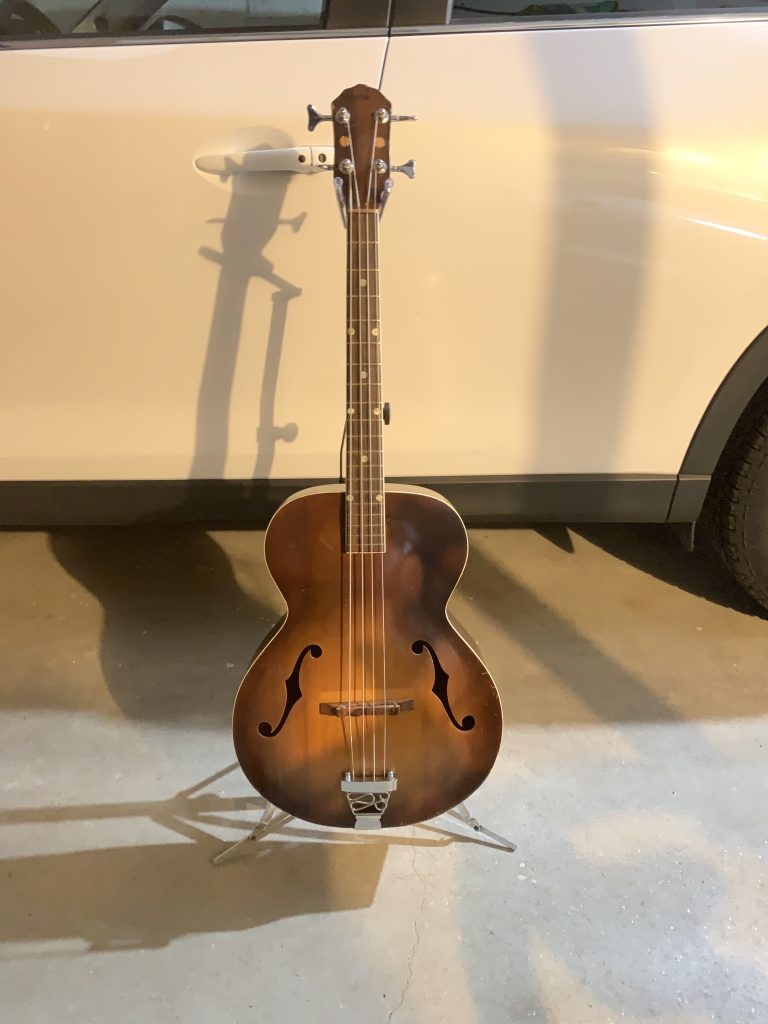
Most likely made in the 1950s, this was my first guitar purchase. (See What Is It? below.) I found it hanging by a rope on the corner of a merchant’s tent at Kobey’s Swap Meet in 1983-ish for $15. It was dusty, dirty, neglected, hardware rusted, only had five tuning buttons, no pickguard but had screw holes from where it was once attached– but was in good shape otherwise, no cracks. The strings must have been 20 years old at least, all black and rusty, wayyyy out of tune and seemed like they would break if I tried to tune it up. I asked the guy if he’d take $10 and we settled on $12, which I promptly borrowed from my sister because of course I had no money. Most of my early guitar playing and learning was on this. Archtop acoustics have a distinct tone, not like regular, modern flat top acoustics (usually lighter colored wood top, with a round hole in the middle) which are much more popular these days. Their top where the F-holes are, are usually hand carved on the outside and inside to give them the distinct look, much like a violin, cello or doublebass. The other guitar we had in the house were a cheapie classical acoustic my sister got for Christmas maybe 10 years before and later an Encore electric guitar that her boyfriend gave us.
When I first bought this acoustic, I really didn’t know anything about guitars, so shined it up as best as I could, bought a pack of La Bella acoustic strings for it and man, was it hard to play. My dad, brother and I went to Garza’s Music (our local music shop in Chula Vista, CA) and I asked Magic Mike the salesguy if he knew anything about it and what he thought of it. “You got a fireplace?!” he joked. I think he saw the disappointment on my face when he said that so he went on to add in a more serious tone “It’s probably a 1950 or so Sears or [Montgomery] Monkey Wards type guitar” and remarked on the incredibly high action and how it was probably used for slide guitar. It was crazy high action. My dad asked him if that could be fixed and Mike said that if we could saw the rosewood saddle in half (see Photoshopped saddle below), it would make a difference. Mike also said “Some stoop glued the bridge to the body so you should fix that.” Yeah, that was me, but I didn’t own up to it out loud. He sold me some Ernie Ball Slinky guitar strings as he said since the neck was a bit warped, the lighter gauge strings were better for it than the heavy acoustic ones I had on it.

That day back at home, my dad rigged up his jigsaw, held in place upside down in the workshop bench vise on low speed. He and I took the guitar saddle and carefully guided it through the reciprocating jigsaw blade, careful to keep it centered on our pencil line and our fingers clear of the blade! The posts on the bridge also needed to be shortened and he helped me with that. After that it was much easier to play.
I used it as my only acoustic guitar until 2002. It went with me to Phoenix where I lived for a couple of semesters after high school with my brother. He and I used to jam, he on his Seagull acoustic; it was one of my favorite things to do. Usually just 12 bar blues and we’d take turn improvising Pentatonic solos over the other guy holding down the rhythm. That morphed into playing our bluesy version of “Owner Of Lonely Heart” doing the same improvising.
Looking back, I should have saved the 5 good Kluson tuners that it had on it. Since it only had 5 tuner buttons on it and a empty post I could use a pair of pliers on or the old ignition tumbler thumb and finger switch thingie from our old Cadillac that fit perfectly on the post to turn it. The only replacements I could get were a set of Grover tuners that would have looked better on a Les Paul, but this was done way before ordering parts on the Internet existed. The name Bank Robber came about because the original tuners were so hard to turn (maybe I should have actually oiled them) and I felt the tension was so high on the strings, that I told my friend John that I could hold up a bank by bringing my guitar in and threatening to tune it unless they gave me all their money. I turned it into an acoustic bass a few years ago–everything is reversible, so no harm was done to it.
What is it?
There’s no marking on the guitar, so I have to rely on some of the other similar guitars I’ve seen like it. Here are some of the Kay and Harmony archtops I’ve come across that remind of mine. It could be a no-name guitar from a local music shop or Monkey Wards like Magic Mike said, since the Kay factory made not only Kays.
Kay-made guitars – as well as those built by local rivals Harmony – were marketed under many names, depending on the catalogue they were sold out of: Silvertone, sold by Sears; Truetone, sold out of Western Auto; Custom Kraft, the house brand for the St Louis Supply Company; department store JCPenney’s Penncrest line; Airline, originally marketed and sold by Montgomery Ward; Old Kraftsman, the Spiegel catalogue brand; and Rex parlor guitars, sold by Gretsch.
Guitar.com: The untold history of Kay Guitars
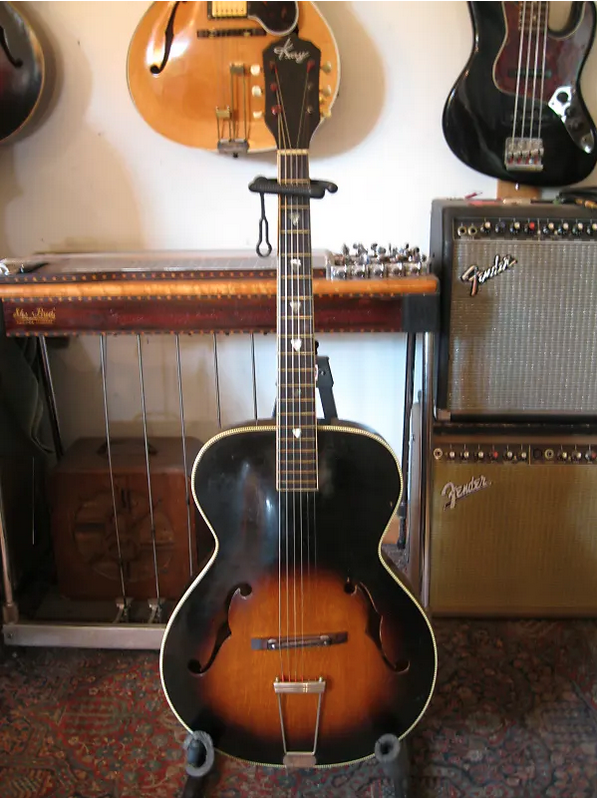
This 1957 Kay N2 is close, but mine doesn’t have the checkerboard binding, just regular creme binding. Also the headstock is the same shape, but there’s no logo on mine. The inlay dots are larger than normal on this one but mine has doubles on the 5th, 7th and 12th frets. Interesting, this one has the same tuners too!
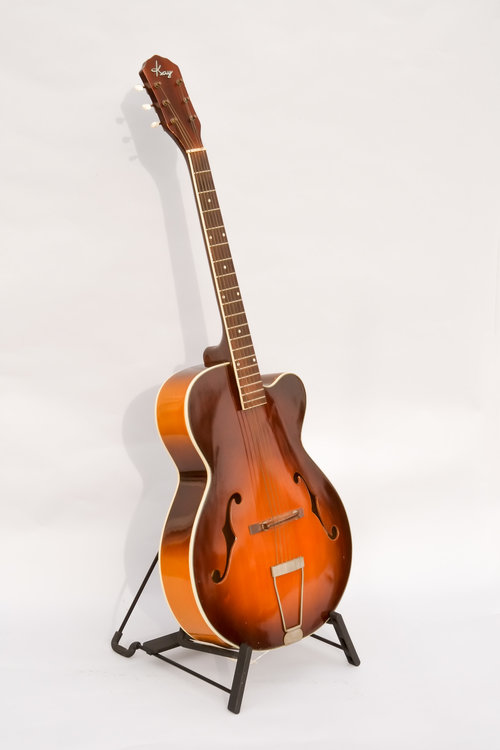
This 1950s Kay is close again with the inlay dots, but it’s a single-cut unlike mine.
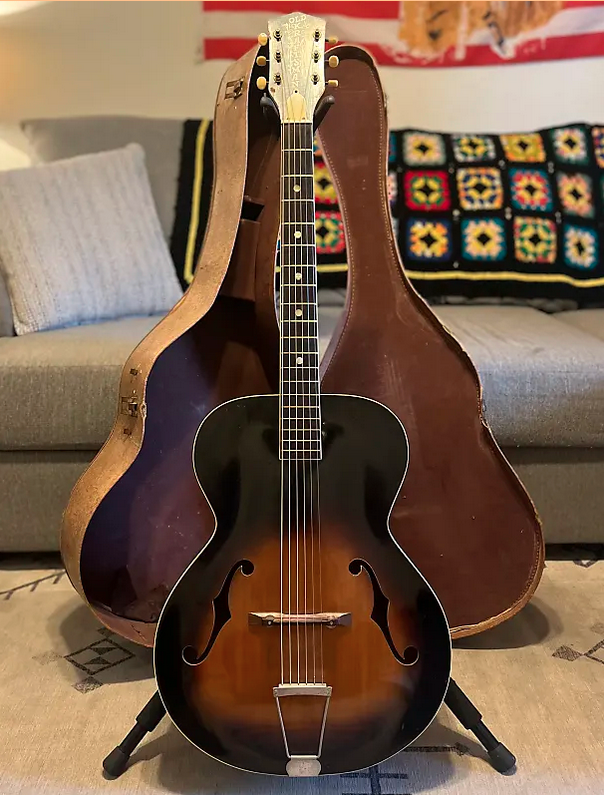
The inlays on this Old Craftsman are closer, but don’t have the doubles like mine. Photos of its side and close ups of the end of the fingerboard over the body remind me of my guitar. Same tuners too, eh?
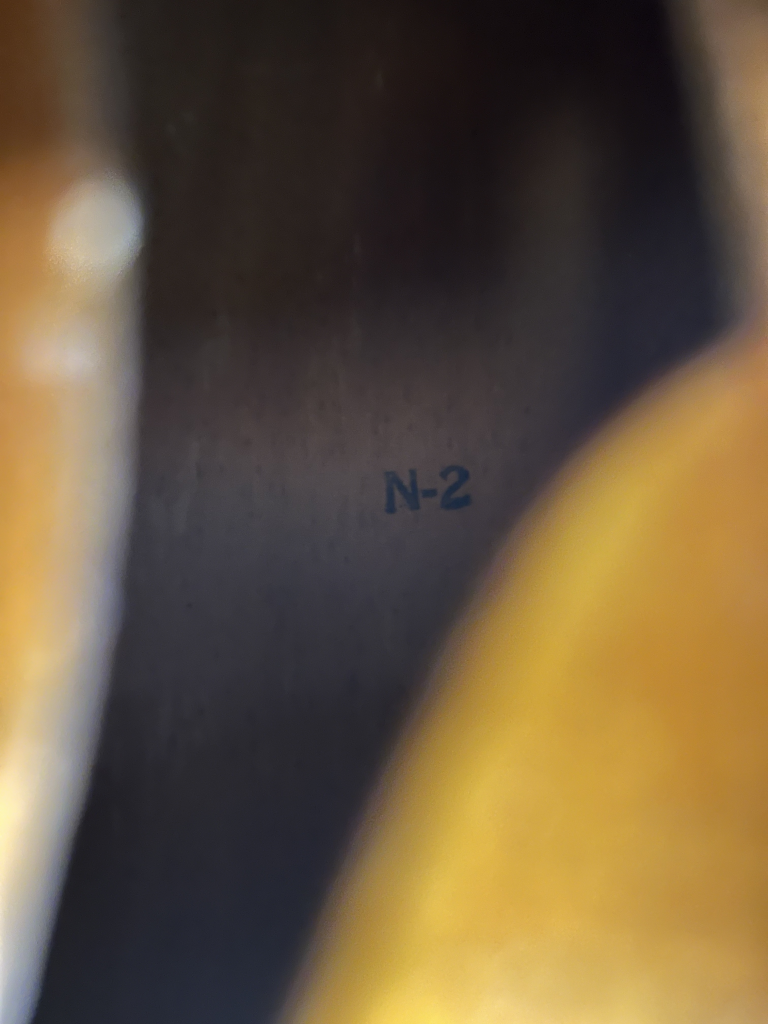
Peeking inside one of my guitar’s f-holes, there’s an N-2 stamp on one side and a batch number, L with 4 numbers a space and 4 more numbers through the other f-hole. From what I’ve read, there’s no date code in there, simply batch numbers. Kind of a bummer but I’m fairly confident mine dates between a 1957 and 1958 based on its headstock and tuners.
Back To Glory
With my doubleneck guitar build published in Premiere Guitar, Allparts.com was nice enough to give me a $100 gift card to their website! I used some of that to buy replacement tuners and a bracket for a pickguard, which I’ve been meaning to put on this for 40 years and never got around to it. Also, while it’s on the bench, I’m going to clean it up good and bring it back to the way it was before I converted it to a bass. It really didn’t work that well as a bass and I miss playing it! Stay tuned!